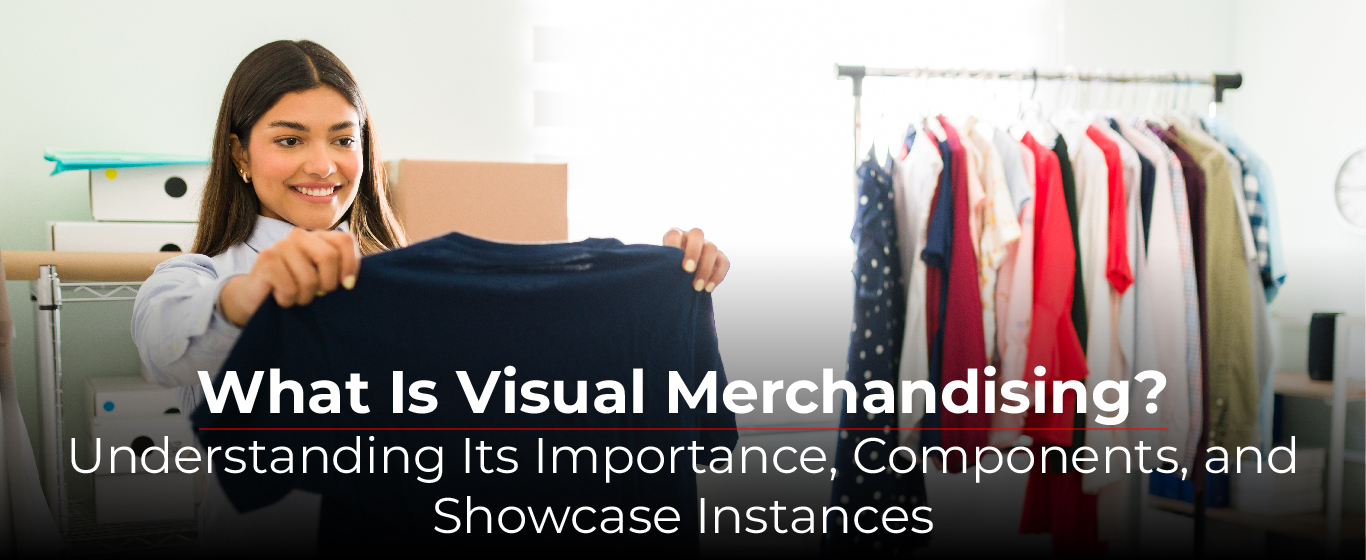
Visual merchandising encompasses the visual impression one encounters upon entering a retail establishment. It involves the artful arrangement and organization of products both within the store and on displays, all designed to captivate customer attention, encourage purchases, and cultivate customer loyalty.
This well-structured strategy holds the power to shape customer choices within a store, making it an indispensable component of retail marketing.
Now, let’s delve into the details of what visual merchandising is, its significance, and how it operates. This guide will provide a comprehensive explanation.
What Is Visual Merchandising?
Visual merchandising encompasses the art of arranging and presenting products within a retail environment. This practice aims to accentuate product attributes, capture customer attention, ensure their comfort, and boost sales. Initially rooted in physical retail stores, these techniques are now also applied to digital storefronts.
Effective visual merchandising employs various tangible elements to convey a brand’s identity and style, including:
- Color: The choice of colors can evoke different emotions and set the tone. It’s crucial to select a color scheme that aligns with your company’s brand image.
- Lighting: Lighting plays a pivotal role in establishing the ambiance within your space and directing focus towards specific products or areas within your store.
- Layout: The layout and spatial design of your store influence how customers navigate through it, where they linger, and what they encounter.
- Sound: The auditory atmosphere, whether it be soothing nature sounds or energetic music, contributes to the overall ambiance in your space.
- Fragrance: Particular scents can evoke distinct emotions, such as tranquility or excitement, and trigger positive associations. For instance, the scent of evergreen can evoke holiday memories.
- Technology: Incorporating technology, such as digital displays and interactive installations, can heighten customer engagement with your brand.
The Significance of Robust Visual Merchandising
Visual merchandising serves as a potent tool for cutting through the clutter. In both physical retail spaces and digital storefronts, consumers are bombarded with a barrage of visual and text-based advertisements. Amidst this cacophony of products vying for attention, it’s all too easy for shoppers to become overwhelmed and overlook the majority of offerings. They often find it simpler to keep their heads down and swiftly locate the specific product they came for.
The primary objective of visual merchandising is to captivate and engage customers, ultimately prompting them to make purchases.
For the visual merchandiser, the task predominantly revolves around shaping the architectural layout of the entire retail environment, whether it be a brick-and-mortar store, a website, or a mobile application.
Once this foundational framework is established, the visual merchandiser’s ultimate role is to craft spaces that seamlessly blend the distinctive features of individual products with the overarching brand aesthetic. This fusion should effectively convey the value of each item as well as the brand’s identity as a whole. It entails orchestrating the customer experience across all touch-points in a manner that imparts the desired knowledge about your products and brand, all without relying heavily on copious amounts of text.
We’re all acquainted with the classic “AIDA Model” sales funnel: Attention, Interest, Decision, Action. Visual merchandising operates at the pinnacle of this funnel. It must not only capture attention but also kindle interest, guiding otherwise passive browsers deeper into the decision-making process.
Now, contemplate the alternative scenario: Every product is displayed side-by-side with little to differentiate them from one another. The store layout remains mute about the brand and makes no effort to entice the shopper to delve deeper into discovery. Clearly, this doesn’t align with a savvy strategy, does it?
Strategies for Enhancing Your Visual Merchandising
Elevating the visual merchandising in your space involves a multifaceted approach. Here are ten effective methods to enhance your visual merchandising efforts:
- Conduct Thorough Research: Utilize market research to discern your target audience’s preferences. Understand their interests, hobbies, and lifestyle. Infuse your space with elements that resonate with your ideal customers. For instance, if parents are your primary audience, consider incorporating images of joyful children and families.
- Prioritize Safety: Ensure that all displays, signage, and structural components, such as shelving, are secure and adhere to safety standards. Follow manufacturer guidelines for installation and maintenance, and enlist professionals for intricate projects involving electrical work or construction.
- Foster Engagement: Leverage interactive displays to heighten customer engagement with your brand. Displays that link to your social media accounts or website can drive online traffic and boost search engine rankings. Creative and interactive displays can also generate word-of-mouth referrals as more people discover your distinctive features.
- Stay Current with Trends: Stay abreast of industry trends, including design, art, and fashion. If, for example, monochromatic fashion is in vogue, consider integrating harmonious color schemes in your store or designing a captivating monochromatic display.
- Consult with Professionals: Contemplate enlisting the expertise of a professional merchandiser to evaluate your space and offer recommendations for better brand representation. They can assist in implementing best practices, fostering customer loyalty, and increasing sales. Professional merchandisers can be found through interior design agencies, fashion and design schools, as well as industry-related websites and publications.
- Integrate Merchandising into Marketing: Regard visual merchandising as an integral component of your marketing strategy. Optimize your physical space to allure customers, showcase your products’ finest attributes, and facilitate sales. Incorporate thoughtful elements that leave a lasting impression and prompt customers to share their experience.
- Experiment with Merchandising Variations: To identify the most effective merchandising strategies, conduct tests by introducing slight variations in layout, color schemes, signage, and displays for a defined period. Compare sales, foot traffic, or other metrics to determine which option yields superior results.
- Regularly Revise Your Space: Maintain balance in your visual merchandising elements to ensure they pique interest without overwhelming customers. Regularly assess your store to confirm that your visual components are enhancing your brand rather than diverting attention from your products or services.
- Embrace Thematic Elements: Consider infusing themes throughout your space to align with new product launches, seasonal items, or special promotions. Themes can range from coordinating colors to immersive narratives or customer testimonials. Employing themes can effectively differentiate specific products or features you wish to emphasize.
- Maintain Consistency: Uphold consistency in your brand identity and messaging across both physical and digital realms. Ensure that your tone, style, and messaging remain cohesive throughout your store, website, and social media platforms. This fosters brand awareness across all channels, enabling customers to readily recognize your products and fostering trust among consumers.
Advantages of Visual Merchandising
Visual merchandising offers a range of benefits applicable to various types of retail stores. Some of the key advantages include:
- Brand Alignment: Effective visual merchandising ensures that displays align with the company’s overall brand. For instance, in a franchise business, consistent promotional displays across all franchisees reinforce a sense of identity and brand uniformity.
- Customer Engagement: A visually appealing and inviting store creates a positive initial impression, enticing customers to enter. It also assists them in locating the right products for their needs. Visual merchandising contributes to a favorable shopping experience, increasing the likelihood of return visits.
- Sales Growth: When executed skillfully, visual merchandising can boost sales by guiding customers to desired products and encouraging the discovery of new items and solutions. For example, a well-dressed mannequin can inspire customers to explore outfits and accessories they may not have initially sought.
Whether your retail offerings include clothing, hardware, electronics, food, or any other products, a proficient visual merchandiser can be a valuable asset to your team. They can help your retail business achieve the desired results and enhance the overall shopping experience for your customers.
Apply now – Head of Visual Merchandising Jobs
Apply now – https://www.shrofile.com/jobs.php
Let Shrofile Executive Search Find You Transformational Talent
Does your company need a dynamic and forward-thinking leader? Get in touch today and learn more about how we find and place transformational talent.
For more Updates
Website – www.shrofile.com
Facebook page – https://www.facebook.com/shrofile/
Twitter page – https://twitter.com/shrofile
Linkedin Page – https://www.linkedin.com/company/shrofile/
YouTube Page – https://www.youtube.com/channel/UChVfJqpTjx1dHJ2xq_dMtAw
Instagram Page – https://www.instagram.com/Shrofile/




